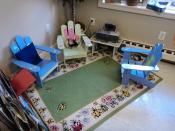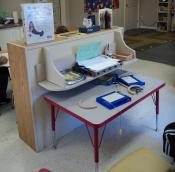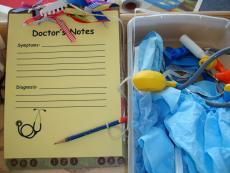 We are continuing to read “Literacy Beginnings” (Fountas & Pinnell) for the Book Study Blog Party. Let’s dive into chapter 4 – An Organized, Engaging Environment!
We are continuing to read “Literacy Beginnings” (Fountas & Pinnell) for the Book Study Blog Party. Let’s dive into chapter 4 – An Organized, Engaging Environment!
I loved this chapter because it gave some great examples of ways to setup your early learning classroom. It’s always nice to be able to see how other teachers setup their classroom, and this chapter had some photos of classrooms to further illustrate the points made in the chapter.
This chapter focuses on organizing your classroom space so that materials are:
• easily accessible to children
• not cluttered
• well-stocked (but not overwhelmingly so)
• rotated throughout the year
On page 44, there is a list of tips for organizing your classroom. It makes for a good checklist that teachers can use when getting their classrooms ready for the start of the school year. It highlights many of the criteria that are required by programs accredited by NAEYC. A few of the tips mentioned here are:
• displaying children’s artwork throughout the classroom (and at eye-level)
• labeling shelves and containers with pictures and words
• using low shelving (so it is child-accessible)
• arranging furniture purposefully (to define learning areas and create safe traffic patterns in the classroom)
The chapter then continues with a description of each learning area, and describes the types of materials that can be incorporated into them to promote literacy. I’ll highlight three of the learning areas and some ideas we found for them.
Listening area
This can be part of your library/reading area, or a separate space altogether. It can be very simple to setup, with just an audio player, headphones and a selection of books on tape/CD.
Don’t have any books on tape? They can usually be borrowed from local libraries. But a really creative idea from the book was to have teachers or family members record themselves reading a book that you have in your library!
Here is a picture of a listening center that used child-sized outdoor wooden chairs for seating:

Writing center
This area should include lots of different materials to practice writing and bookmaking. Items such as stamps, stencils, paper clips, envelopes as well as pencils, crayons and markers. One other great idea was to include prestapled blank books. Usually, we’ve had children make books and then try to staple all the pages together afterward – but I thought having that pre-done would encourage more bookmaking!
Don’t have a lot of space in your classroom? Here’s center that uses the back of a bookcase as a backdrop to set up a writing center.

Dramatic Play/Play Corner/Home living
This area includes lots of props and materials that encourage pretend play and role playing. There are lots of ways to incorporate literacy through such props as adding menus to play restaurant, cards and envelopes to play post office, pretend money and checkbook to play bank/store, or using a clipboard and paper to take notes when playing doctor.
Including paper and writing materials in this center gives children the chance to mimic the adult writing they see happen in their everyday lives.
I very much enjoyed this chapter! The full review of this chapter can be found at PreKinders. Pop over to see some of the great ideas and photos!
Grab the button below:



Leave a Reply